Yunhui Liu
Prescribed Performance Control of Deformable Object Manipulation in Spatial Latent Space
Oct 16, 2025Abstract:Manipulating three-dimensional (3D) deformable objects presents significant challenges for robotic systems due to their infinite-dimensional state space and complex deformable dynamics. This paper proposes a novel model-free approach for shape control with constraints imposed on key points. Unlike existing methods that rely on feature dimensionality reduction, the proposed controller leverages the coordinates of key points as the feature vector, which are extracted from the deformable object's point cloud using deep learning methods. This approach not only reduces the dimensionality of the feature space but also retains the spatial information of the object. By extracting key points, the manipulation of deformable objects is simplified into a visual servoing problem, where the shape dynamics are described using a deformation Jacobian matrix. To enhance control accuracy, a prescribed performance control method is developed by integrating barrier Lyapunov functions (BLF) to enforce constraints on the key points. The stability of the closed-loop system is rigorously analyzed and verified using the Lyapunov method. Experimental results further demonstrate the effectiveness and robustness of the proposed method.
Programmable Locking Cells (PLC) for Modular Robots with High Stiffness Tunability and Morphological Adaptability
Sep 09, 2025Abstract:Robotic systems operating in unstructured environments require the ability to switch between compliant and rigid states to perform diverse tasks such as adaptive grasping, high-force manipulation, shape holding, and navigation in constrained spaces, among others. However, many existing variable stiffness solutions rely on complex actuation schemes, continuous input power, or monolithic designs, limiting their modularity and scalability. This paper presents the Programmable Locking Cell (PLC)-a modular, tendon-driven unit that achieves discrete stiffness modulation through mechanically interlocked joints actuated by cable tension. Each unit transitions between compliant and firm states via structural engagement, and the assembled system exhibits high stiffness variation-up to 950% per unit-without susceptibility to damage under high payload in the firm state. Multiple PLC units can be assembled into reconfigurable robotic structures with spatially programmable stiffness. We validate the design through two functional prototypes: (1) a variable-stiffness gripper capable of adaptive grasping, firm holding, and in-hand manipulation; and (2) a pipe-traversing robot composed of serial PLC units that achieves shape adaptability and stiffness control in confined environments. These results demonstrate the PLC as a scalable, structure-centric mechanism for programmable stiffness and motion, enabling robotic systems with reconfigurable morphology and task-adaptive interaction.
Perceiving and Acting in First-Person: A Dataset and Benchmark for Egocentric Human-Object-Human Interactions
Aug 06, 2025Abstract:Learning action models from real-world human-centric interaction datasets is important towards building general-purpose intelligent assistants with efficiency. However, most existing datasets only offer specialist interaction category and ignore that AI assistants perceive and act based on first-person acquisition. We urge that both the generalist interaction knowledge and egocentric modality are indispensable. In this paper, we embed the manual-assisted task into a vision-language-action framework, where the assistant provides services to the instructor following egocentric vision and commands. With our hybrid RGB-MoCap system, pairs of assistants and instructors engage with multiple objects and the scene following GPT-generated scripts. Under this setting, we accomplish InterVLA, the first large-scale human-object-human interaction dataset with 11.4 hours and 1.2M frames of multimodal data, spanning 2 egocentric and 5 exocentric videos, accurate human/object motions and verbal commands. Furthermore, we establish novel benchmarks on egocentric human motion estimation, interaction synthesis, and interaction prediction with comprehensive analysis. We believe that our InterVLA testbed and the benchmarks will foster future works on building AI agents in the physical world.
RationalVLA: A Rational Vision-Language-Action Model with Dual System
Jun 12, 2025Abstract:A fundamental requirement for real-world robotic deployment is the ability to understand and respond to natural language instructions. Existing language-conditioned manipulation tasks typically assume that instructions are perfectly aligned with the environment. This assumption limits robustness and generalization in realistic scenarios where instructions may be ambiguous, irrelevant, or infeasible. To address this problem, we introduce RAtional MAnipulation (RAMA), a new benchmark that challenges models with both unseen executable instructions and defective ones that should be rejected. In RAMA, we construct a dataset with over 14,000 samples, including diverse defective instructions spanning six dimensions: visual, physical, semantic, motion, safety, and out-of-context. We further propose the Rational Vision-Language-Action model (RationalVLA). It is a dual system for robotic arms that integrates the high-level vision-language model with the low-level manipulation policy by introducing learnable latent space embeddings. This design enables RationalVLA to reason over instructions, reject infeasible commands, and execute manipulation effectively. Experiments demonstrate that RationalVLA outperforms state-of-the-art baselines on RAMA by a 14.5% higher success rate and 0.94 average task length, while maintaining competitive performance on standard manipulation tasks. Real-world trials further validate its effectiveness and robustness in practical applications. Our project page is https://irpn-eai.github.io/rationalvla.
HandCept: A Visual-Inertial Fusion Framework for Accurate Proprioception in Dexterous Hands
May 13, 2025Abstract:As robotics progresses toward general manipulation, dexterous hands are becoming increasingly critical. However, proprioception in dexterous hands remains a bottleneck due to limitations in volume and generality. In this work, we present HandCept, a novel visual-inertial proprioception framework designed to overcome the challenges of traditional joint angle estimation methods. HandCept addresses the difficulty of achieving accurate and robust joint angle estimation in dynamic environments where both visual and inertial measurements are prone to noise and drift. It leverages a zero-shot learning approach using a wrist-mounted RGB-D camera and 9-axis IMUs, fused in real time via a latency-free Extended Kalman Filter (EKF). Our results show that HandCept achieves joint angle estimation errors between $2^{\circ}$ and $4^{\circ}$ without observable drift, outperforming visual-only and inertial-only methods. Furthermore, we validate the stability and uniformity of the IMU system, demonstrating that a common base frame across IMUs simplifies system calibration. To support sim-to-real transfer, we also open-sourced our high-fidelity rendering pipeline, which is essential for training without real-world ground truth. This work offers a robust, generalizable solution for proprioception in dexterous hands, with significant implications for robotic manipulation and human-robot interaction.
A Pre-Training and Adaptive Fine-Tuning Framework for Graph Anomaly Detection
Apr 19, 2025Abstract:Graph anomaly detection (GAD) has garnered increasing attention in recent years, yet it remains challenging due to the scarcity of abnormal nodes and the high cost of label annotations. Graph pre-training, the two-stage learning paradigm, has emerged as an effective approach for label-efficient learning, largely benefiting from expressive neighborhood aggregation under the assumption of strong homophily. However, in GAD, anomalies typically exhibit high local heterophily, while normal nodes retain strong homophily, resulting in a complex homophily-heterophily mixture. To understand the impact of this mixed pattern on graph pre-training, we analyze it through the lens of spectral filtering and reveal that relying solely on a global low-pass filter is insufficient for GAD. We further provide a theoretical justification for the necessity of selectively applying appropriate filters to individual nodes. Building upon this insight, we propose PAF, a Pre-Training and Adaptive Fine-tuning framework specifically designed for GAD. In particular, we introduce joint training with low- and high-pass filters in the pre-training phase to capture the full spectrum of frequency information in node features. During fine-tuning, we devise a gated fusion network that adaptively combines node representations generated by both filters. Extensive experiments across ten benchmark datasets consistently demonstrate the effectiveness of PAF.
Fish Mouth Inspired Origami Gripper for Robust Multi-Type Underwater Grasping
Mar 14, 2025



Abstract:Robotic grasping and manipulation in underwater environments present unique challenges for robotic hands traditionally used on land. These challenges stem from dynamic water conditions, a wide range of object properties from soft to stiff, irregular object shapes, and varying surface frictions. One common approach involves developing finger-based hands with embedded compliance using underactuation and soft actuators. This study introduces an effective alternative solution that does not rely on finger-based hand designs. We present a fish mouth inspired origami gripper that utilizes a single degree of freedom to perform a variety of robust grasping tasks underwater. The innovative structure transforms a simple uniaxial pulling motion into a grasping action based on the Yoshimura crease pattern folding. The origami gripper offers distinct advantages, including scalable and optimizable design, grasping compliance, and robustness, with four grasping types: pinch, power grasp, simultaneous grasping of multiple objects, and scooping from the seabed. In this work, we detail the design, modeling, fabrication, and validation of a specialized underwater gripper capable of handling various marine creatures, including jellyfish, crabs, and abalone. By leveraging an origami and bio-inspired approach, the presented gripper demonstrates promising potential for robotic grasping and manipulation in underwater environments.
Norm Augmented Graph AutoEncoders for Link Prediction
Feb 09, 2025



Abstract:Link Prediction (LP) is a crucial problem in graph-structured data. Graph Neural Networks (GNNs) have gained prominence in LP, with Graph AutoEncoders (GAEs) being a notable representation. However, our empirical findings reveal that GAEs' LP performance suffers heavily from the long-tailed node degree distribution, i.e., low-degree nodes tend to exhibit inferior LP performance compared to high-degree nodes. \emph{What causes this degree-related bias, and how can it be mitigated?} In this study, we demonstrate that the norm of node embeddings learned by GAEs exhibits variation among nodes with different degrees, underscoring its central significance in influencing the final performance of LP. Specifically, embeddings with larger norms tend to guide the decoder towards predicting higher scores for positive links and lower scores for negative links, thereby contributing to superior performance. This observation motivates us to improve GAEs' LP performance on low-degree nodes by increasing their embedding norms, which can be implemented simply yet effectively by introducing additional self-loops into the training objective for low-degree nodes. This norm augmentation strategy can be seamlessly integrated into existing GAE methods with light computational cost. Extensive experiments on various datasets and GAE methods show the superior performance of norm-augmented GAEs.
Learning Accurate, Efficient, and Interpretable MLPs on Multiplex Graphs via Node-wise Multi-View Ensemble Distillation
Feb 09, 2025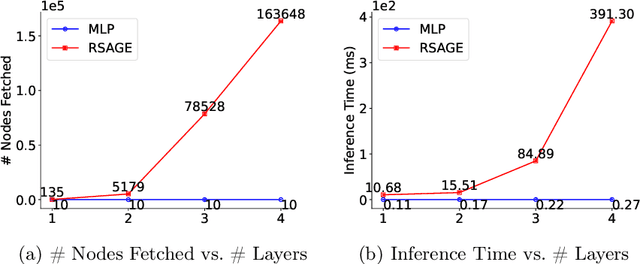
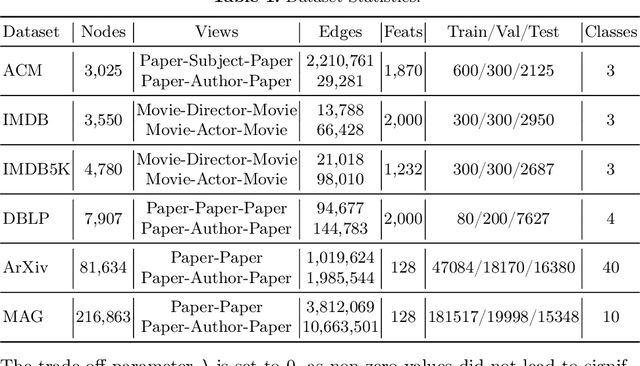


Abstract:Multiplex graphs, with multiple edge types (graph views) among common nodes, provide richer structural semantics and better modeling capabilities. Multiplex Graph Neural Networks (MGNNs), typically comprising view-specific GNNs and a multi-view integration layer, have achieved advanced performance in various downstream tasks. However, their reliance on neighborhood aggregation poses challenges for deployment in latency-sensitive applications. Motivated by recent GNN-to-MLP knowledge distillation frameworks, we propose Multiplex Graph-Free Neural Networks (MGFNN and MGFNN+) to combine MGNNs' superior performance and MLPs' efficient inference via knowledge distillation. MGFNN directly trains student MLPs with node features as input and soft labels from teacher MGNNs as targets. MGFNN+ further employs a low-rank approximation-based reparameterization to learn node-wise coefficients, enabling adaptive knowledge ensemble from each view-specific GNN. This node-wise multi-view ensemble distillation strategy allows student MLPs to learn more informative multiplex semantic knowledge for different nodes. Experiments show that MGFNNs achieve average accuracy improvements of about 10% over vanilla MLPs and perform comparably or even better to teacher MGNNs (accurate); MGFNNs achieve a 35.40$\times$-89.14$\times$ speedup in inference over MGNNs (efficient); MGFNN+ adaptively assigns different coefficients for multi-view ensemble distillation regarding different nodes (interpretable).
Multi-Scale Heterogeneous Text-Attributed Graph Datasets From Diverse Domains
Dec 12, 2024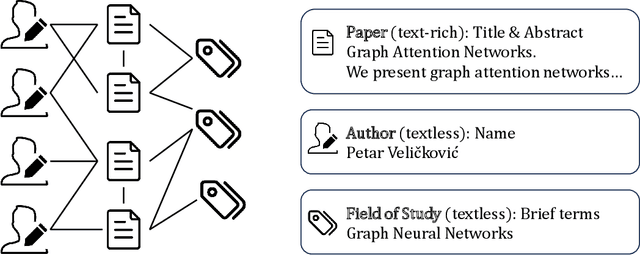
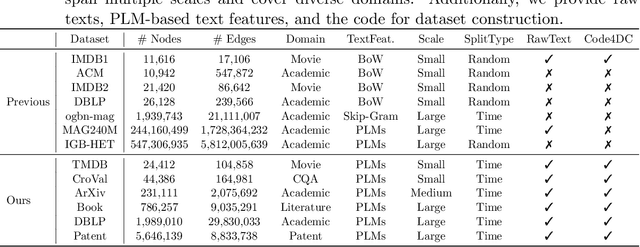
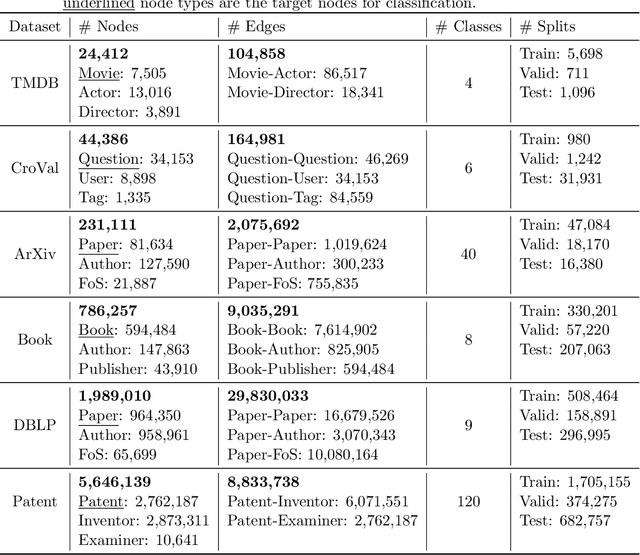
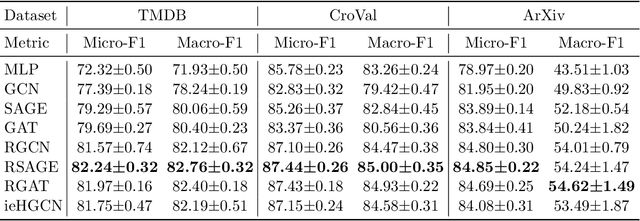
Abstract:Heterogeneous Text-Attributed Graphs (HTAGs), where different types of entities are not only associated with texts but also connected by diverse relationships, have gained widespread popularity and application across various domains. However, current research on text-attributed graph learning predominantly focuses on homogeneous graphs, which feature a single node and edge type, thus leaving a gap in understanding how methods perform on HTAGs. One crucial reason is the lack of comprehensive HTAG datasets that offer original textual content and span multiple domains of varying sizes. To this end, we introduce a collection of challenging and diverse benchmark datasets for realistic and reproducible evaluation of machine learning models on HTAGs. Our HTAG datasets are multi-scale, span years in duration, and cover a wide range of domains, including movie, community question answering, academic, literature, and patent networks. We further conduct benchmark experiments on these datasets with various graph neural networks. All source data, dataset construction codes, processed HTAGs, data loaders, benchmark codes, and evaluation setup are publicly available at GitHub and Hugging Face.
 Add to Chrome
Add to Chrome Add to Firefox
Add to Firefox Add to Edge
Add to Edge